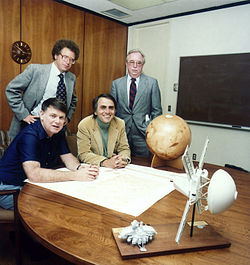
Back الجمعية الكوكبية Arabic দ্য প্ল্যানেটারি সোসাইটি Bengali/Bangla The Planetary Society Catalan The Planetary Society German Planeda Societo Esperanto Sociedad Planetaria Spanish انجمن سیارهای Persian The Planetary Society French האגודה הפלנטרית HE द प्लैनेटरी सोसाइटी Hindi
 | |
| Formation | 1980 |
|---|---|
| Type | Non-governmental and nonprofit foundation, 501(c)(3) |
| 95-3423566 | |
| Registration no. | C0946337 |
| Location | |
| Fields | Space advocacy |
| Members | 60,000 |
Key people | Louis Friedman, Bill Nye, Neil deGrasse Tyson, Carl Sagan, Bruce C. Murray |
| Website | www |

The Planetary Society is an American internationally-active non-governmental nonprofit organization.[1] It is involved in research, public outreach, and political space advocacy for engineering projects related to astronomy, planetary science, and space exploration. It was founded in 1980 by Carl Sagan, Bruce Murray, and Louis Friedman,[2] and has about 60,000 members from more than 100 countries around the world.[3]
The Society is dedicated to the exploration of the Solar System, the search for near-Earth objects, and the search for extraterrestrial life.[4] The society's mission is stated as: "Empowering the world’s citizens to advance space science and exploration."[5] The Planetary Society is a strong advocate for space funding and missions of exploration within NASA. They lobby Congress and engage their membership in the United States to write and call their representatives in support of NASA funding.[5]
In addition to public outreach, The Planetary Society has sponsored solar sail and microorganisms-in-space projects to foster space exploration. In June 2005, the Society launched the Cosmos 1 craft to test the feasibility of solar sailing, but the rocket failed shortly after liftoff.[6][7] LightSail was originally conceived as a series of three solar sail experiments[8] but later shortened to two missions. LightSail 1 launched on May 20, 2015,[9] and demonstrated a test deployment of its solar sail on June 7, 2015.[10] LightSail 2 launched on June 25, 2019,[11] and successfully used sunlight to change its orbit.[12]
Living Interplanetary Flight Experiment (LIFE), was a two-part program designed to test the ability of microorganisms to survive in space.[13] The first phase flew on STS-134, Space Shuttle Endeavour's final flight in 2011.[14] The second phase rode on Russia's Fobos-Grunt mission, which attempted to go to Mars' moon Phobos and back but failed to escape Earth orbit.[15]
- ^ "About Us". The Planetary Society. Retrieved October 30, 2020.
- ^ Spangenburg, Ray; Moser, Diane (2004), Carl Sagan: a biography, Greenwood Publishing Group, p. 107, ISBN 978-0-313-32265-5
- ^ Cite error: The named reference
EL2018was invoked but never defined (see the help page). - ^ "The Planetary Society encourages exploration of the universe to find extraterrestrial life", Los Angeles Times, May 1, 1983
- ^ a b The Planetary Society (2022). "About Us". planetary.org. The Planetary Society. Retrieved November 20, 2022.
- ^ "No Signal From Solar Sail Spacecraft", Fox News, June 21, 2005, archived from the original on October 23, 2012, retrieved July 28, 2009
- ^ Asaravala, Amit (June 23, 2005), "Reality of Cosmos 1 Loss Sets In", Wired
- ^ "LightSail: A Multi-Mission Project" Archived April 1, 2012, at the Wayback Machine, The Planetary Society website. Retrieved 2011-05-05.
- ^ "Liftoff! LightSail Sails into Space aboard Atlas V Rocket". The Planetary Society. Retrieved October 30, 2020.
- ^ "Deployment! LightSail Boom Motor Whirrs to Life". The Planetary Society. Retrieved October 30, 2020.
- ^ "LightSail 2 Has Launched!". The Planetary Society. Retrieved October 30, 2020.
- ^ "LightSail 2 Spacecraft Successfully Demonstrates Flight by Light". The Planetary Society. Retrieved October 30, 2020.
- ^ "LIFE Experiment: Shuttle & Phobos: FAQ", The Planetary Society website. Retrieved 2011-05-05.
- ^ "Planetary Society Welcomes Home Shuttle LIFE Passengers", press release, The Planetary Society website, June 1, 2011. Retrieved 2011-06-15.
- ^ "'January re-entry' for Phobos-Grunt Mars probe", BBC News, December 16, 2011